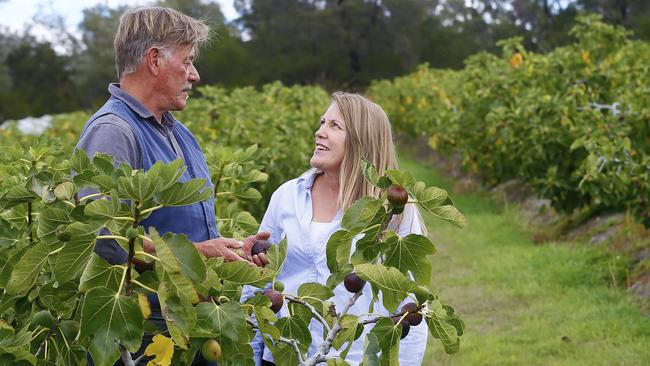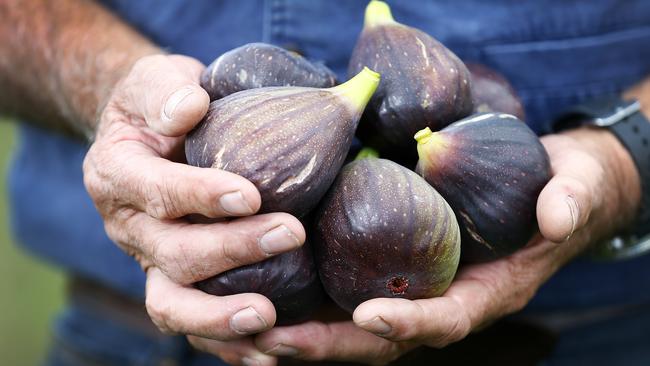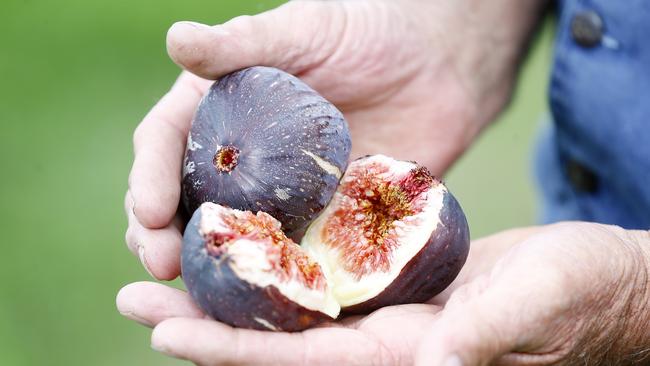Elaine Reeves meets a Tasmanian grower producing luscious, sweet figs in the state’s south-east
For those who do give a fig, this fruit is like a little package from the summer, writes ELAINE REEVES

Taste Tasmania
Don't miss out on the headlines from Taste Tasmania. Followed categories will be added to My News.
THE customer at Farm Gate Market wants Peter Frankham to select four figs for her. She wanted two to eat now and two for tomorrow. “What time tomorrow?” asks Peter, who is the owner, grower and mostly sole picker of Frankham Figs, and he likes his customers to have their figs “just as the Greek gods intended them to be”.
“Figs are such a sexy thing to grow,” he says. “It’s a decadent thing to have figs, a bottle of wine, some cheese … All those hot days of summer, this is what they have produced. A luscious, sweet fig is like a little stolen package from the summer.”

MORE ELAINE REEVES:
DEVITA DAVISON’S GOOD FOOD CRUSADE
FIREY FEAST FOR THE HUON’S FINEST
Getting some of his own summers back was part of Peter’s reason for getting into figs, which are at their peak in autumn. There are only a handful of weeks left in which to buy them. His summers used to be devoted to apricots — Peter set up Qew Orchards at Campania and worked there for 11 years. There he planted 100 Black Genoa fig trees in a couple of rows empty of apricot trees.
Now he has about 1400 fig trees at Dulcot, near Cambridge. Some of them are juveniles “and they take some handling, as teenagers do” but the 400 seven-year-old Black Genoa trees in the main block “are just where I want them”. That is, a loose vase shape. Fig trees are easy to grow, but if not tended to will turn into a bush.
They can also become huge. I visited one on Kangaroo Island in South Australia that is known as the Enchanted Fig Tree. It is 150 years old and spread over a wide area. There are little tunnels and five “rooms” inside the tree, where two women set up tables and run a pop-up restaurant that can seat 40. What that tree is not famous for is its fruit.

MORE ELAINE REEVES:
SAMIN NOSRAT IN DEFENCE OF SALT
Peter says the best way to stop runaway growth of the tree is to “hang some fruit off it”. But while the trees are pretty tough, the fruit is fragile. Peter gets help from his partner Tanya Ahokas when she is not at her paid job, and other members of his family if a glut threatens, but mostly he does the picking himself.
It is very easy to spear the fruit with a finger nail. Once Peter found a piece of loose skin on his hand was damaging them. And you have to have your eye in. “There are only hours between them being perfect and being split,” he said.
A ripe fig will feel cool, even when it has been in the sun, and come off with slight twist. Once a ripe fig is picked, one of the cluster of small green fruits around it will quickly ripen, and when that is picked the next in line ripens.
Birds love them too of course, and some of the trees are under draped nets, but, says Peter, “for the annoyance of working under draped nets I’d rather sacrifice 5 to 10 per cent to the birds. If you’re not wearing a hat it does some weird stuff to your hair; you don’t come out the way you went in, that’s for sure.

Because of the fragility of the figs, only 50 per cent of the pick is packed out as perfect fruit. Peter charges the same amount for every tray of figs, but some will hold 42 in and the biggest ones are only 23 to a tray. Fruit that does not make the moulded trays is sold to Island Berries Tasmania, which uses them for fig paste.
Nigel Slater says in his book on fruit cooking and gardening Tender II: “The fig’s friends, anchovy, pomegranate, almonds, prosciutto, honey, goats cheese and lavender, tell us much about where it feels at home.”
Peter has his own favourite ways of serving one of the oldest fruits in the Mediterranean (along with olives and grapes). He likes them cut in half and grilled with honey and thyme on top, matched with a blue cheese, wrapped in prosciutto, and, a surprising one — cut in half, sprinkled with salt and then drizzled with real-deal balsamic vinegar.
And I’m here to tell you that are extremely good straight from the tree and into your mouth. Frankham Figs are sold at Hill Street stores and Farm Gate Market and, if the gate is open, call into the farm-gate shed with plants growing on the roof at Dulcot.
elaine.reeves@antmail.com.au
MORE ELAINE REEVES:


